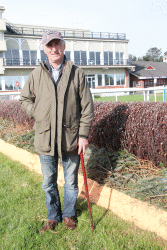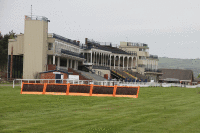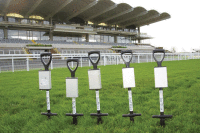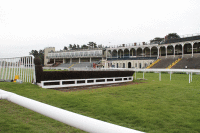Jumping for joy ...

The evocative photograph of a mud-splattered Desert Orchid winning the 1989 Cheltenham Gold Cup is one of the most famous in horseracing. On saturated ground, which almost led to jump racing's most celebrated prize being abandoned, the great grey known to all as 'Dessie' cleared the last fence before setting off in pursuit of Yahoo, who appeared destined to become the ultimate party-pooper.
Sir Peter O'Sullevan's spine-tingling commentary captured the mood perfectly; "There's a tremendous cheer from the crowd as Desert Orchid is going to win it ... Dessie's done it."

However, Oliver found himself drawn towards training, leaving Simon to become a professional jockey. Simon rode for just eight seasons, yet amassed a total of 350 winners. In that time, he was fortunate to be given the chance to ride one of the most iconic horses in British racing.
A jockey needs luck in racing and Simon's was certainly in on Boxing Day 1986, when David Elsworth's stable jockey, Colin Brown, was given the choice of two runners to ride in the King George at Kempton. Colin picked the second favourite, Combs Ditch, leaving Simon to ride the other - Desert Orchid!
The rest is history; Simon went on to ride to victory in that race and managed to keep his partnership with Desert Orchid for a total of nine wins out of ten. They were beaten only once together, when Dessie uncharacteristically fell at Aintree.
He retired on the spur of the moment after riding a winner for his brother at Haydock in May 1989, admitting at the time that; "a little bell had been ringing in my mind saying enough is enough."

On his retirement from the saddle, Simon took out a trainer's licence and claimed a major success when winning the Triumph Hurdle in 1992 with Duke of Monmouth. Simon has also trained a number of Sir Alex Ferguson's horses.
However, after several years training horses, Simon fancied a change and took the opportunity to become Clerk of the Course at Ludlow Racecourse. His vast experience in the horseracing industry certainly stands him in good stead, as one of the main roles is to provide a well prepared course that is safe and consistent for both horse and rider.
I caught up with Simon, who was out walking the course with the aim of declaring the going for the last race meeting of the season. It is the job of the Clerk to declare the state of the going of the track prior to and during the racing event, so that trainers can decide if they want to run their horses.

The system is supported 365 days a year and TurfTrax will contact the racecourse at the 6 day entry stage, 48 hours, 24 hours and on the day of the race to update the going report and distribute to trainers as necessary.
The main driving factor that dictates the state of the going is generally the makeup of the soil profile. Free draining soils will tend to be good to firm, whereas courses with heavy clay soils with little or no drainage will, particularly during the winter months, likely be good to soft or even heavy going.

Racing at Ludlow is becoming more popular; the combination of a rural setting, great prize money and, more importantly, the ability to produce a consistent and safe racing surface, has helped increase the course's popularity.
Ludlow Racecourse is reputed to be one of the UK's oldest. Tradition has it that, in the fourteenth century, soldiers from Ludlow Castle came to the site not only to practise archery but also to match their horses. Records show that the course was in existence as far back as 1729.
The course nestles in the heart of the Shropshire countryside within two miles of Ludlow Castle and the town centre. It is a National Hunt course and stages seventeen meetings a year. It has an 'olde worlde' atmosphere due, in part, to the main stand retaining its original Edwardian facade, and provides a wonderful setting for punters and horses alike.

Simon has three long serving full time staff to help maintain the course; Roger Jones (41 years), Chris Jones (30 years) and Dave Roberts (15 years), along with twelve casuals who undertake additional and ongoing tasks around the ground. This crew also carry out divot repairs after racing and help with moving running rails, and repairing fences.
The full time working day is usually 7.30am to 4.30pm however, on race days, they will often put in a twelve hour shift. It can take up to three hours to move the running rails and, if watering is required, can take even longer. Most of the course preparation work is done in the week leading up to the race meeting, usually getting the mowing done the day before a meeting.

They run a very tight ship at Ludlow. Equipment is the minimum needed to maintain the course. Dave drives a Case tractor to operate the front mounted 12ft Votex mower which is used to cut all twenty acres of grass on the course.
It usually takes a full day to mow the complete course; the turf is maintained at a height of 75mm between May and September and raised to 110mm during the October to May racing season.
Keeping enough moisture in the ground during the summer months and early autumn is one of Simon's main priorities. To help him achieve this, he has three 250 metre Bauer hose reels and booms for use around the course. Water is sourced from a reservoir and a bore hole on the course and is pumped through one and a half miles of six inch ring main.
He applies between 10-18mm of water on each application, aiming to maintain the course with a going of good to soft/firm or better during the racing season.

Two applications of low nitrogen compound fertiliser are applied during the growing season to stimulate root growth.
A contractor is called in to carry out selective weed control during the summer months when the weeds are most active. Particular attention is paid to areas of clover which can create a slippery surface if left to get out of hand.
As for pest control, it is a case of keeping an eye out for any leatherjacket activity or any outbreaks of turf disease. Red thread can be quite prolific at certain times of the year, but is easily controlled with a decent feeding programme.
A timely programme of deep tining is undertaken around September time using their own Verti-Drain. Special attention is paid to take off and landing areas where the soil is prone to compaction. Other areas that require additional attention are the golf club's fairways, which are prone to deep compaction due to the daily golf foot traffic.
These areas also get scarified, decompacted and overseeded to increase grass coverage.

During the summer, all the fences are repaired and dressed up for the coming racing season. All are built by hand by Simon's staff. The fences are completely renewed every other year with birch supplied from Yorkshire and spruce sourced locally.
This year, Simon has arranged for the replacement of the permanent fences with new portable ones which allows mowing and repairs to be carried out more easily to take offs and landings.
Each year, Simon gets an annual report from the STRI, who usually visit in March to take a number of soil samples, monitor grass density and generally inspect the course, looking for any problems in relation to compaction, weed and pest problems. A written report is then provided, giving advice and recommendations on relevant renovation, maintenance operations and fertiliser programmes that will benefit the course the following year.
On a personal note, Simon has an interest in many sports. He loves watching rugby and, when time permits, tries to maintain a healthy 15 golf handicap. He has already managed a few rounds of golf after work and is developing a good working relationship with Michael Hughes, Ludlow Golf Club's Head Greenkeeper.
With Simon new at the helm, but with a huge understanding of the needs and aspirations of the trainers and owners, he will continue to work hard to improve the racing conditions. It would appear that Ludlow Racecourse have appointed well and the future looks very bright for this beautiful Shropshire racecourse.

Designed and built by Cranfield University and now managed by TurfTrax, the electronic GoingStick system has been in official use for a number of years now. A variety of readings are taken with the device at various known data points set around the course and the data is then sent to Turftrax who are able to provide up to date going maps for every racecourse in the UK.
Using a standardised and systematic approach to each going report helps to build up a highly detailed audit trail for Clerks and groundstaff. When used over a sustained period of time, this audit trail provides a database of information on which future course management decisions may be made.
Initially, a full Differential Global Positional System (DGPS) survey will be carried out on the course by TurfTrax. This typically involves a site visit lasting up to two days to accurately map the outline of the course as well as all key features, including starts, furlong markers, finish lines and fence positions.
Along with the DGPS survey, a full EMI soil scan and topography survey can be included. This information is used to build up a picture of the course and identify where there is likely to be variability in going.
The EMI and topography scans themselves are useful tools for any planned changes to course layout, design and/or drainage projects.
Once the initial survey is completed and fully analysed, the Going Grid map is prepared showing each area in which GoingStick or official going readings should be taken, to produce an overall map.
Typically, the map is displayed on the TurfTrax website with a direct link on the racecourse website which updates automatically with each going report. This provides an excellent opportunity for the course to remind trainers of a forthcoming race meeting and perhaps increase entry numbers.
Additionally, SMS text messages can be used to alert trainers, this method is particularly useful for last minute going changes or inspection/abandonment information.
